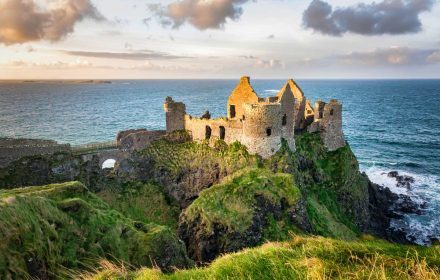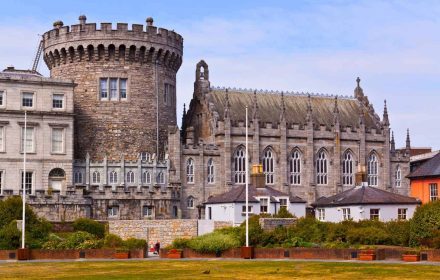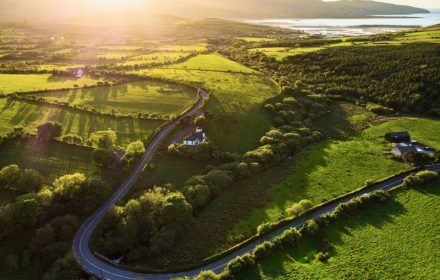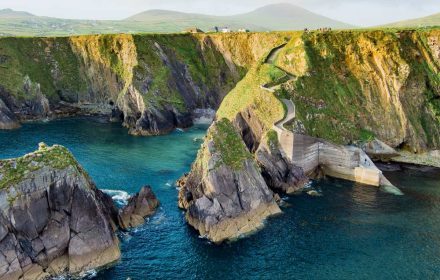This site uses affiliate links, meaning that if you make a purchase through our links, we may earn an affiliate commission.
Planning your first trip to Ireland? Get ready for an incredible experience! In this guide, we’ve compiled a list of must-see sights and attractions in Ireland.
From the towering Cliffs of Moher to the ancient halls of Dublin Castle, we’ll be your compass as you navigate through Ireland’s must-see landmarks.
- 1. Cliffs of Moher
- 2. Guinness Storehouse
- 3. Ring of Kerry
- 4. Giant's Causeway
- 5. Blarney Castle and Gardens
- 6. Dublin Castle
- 7. Rock of Cashel
- 8. Skellig Michael
- 9. Titanic Belfast
- 10. The Burren
- 11. Killarney National Park
- 12. Newgrange
- 13. Trinity College and the Long Room
- 14. Temple Bar District
- 15. Kilmainham Gaol
- 16. The Jameson Distillery
- 17. The Dark Hedges
- 18. Dingle Peninsula
- 19. Carrick-a-Rede Rope Bridge
- 20. Dunluce Castle
Cliffs of Moher
The Cliffs of Moher stand as one of Ireland’s most iconic natural wonders, towering 702 feet above the Atlantic Ocean along the country’s west coast.
Stretching over 5 miles, these sheer cliffs offer breathtaking views of the rugged coastline and the Aran Islands.
INTREPID’S TIP: Explore the Cliffs of Moher Visitor Experience, which provides informative exhibits and viewpoints for optimal appreciation of the stunning scenery. Don’t miss O’Brien’s Tower, a historic observation tower offering panoramic vistas of the surrounding landscape.
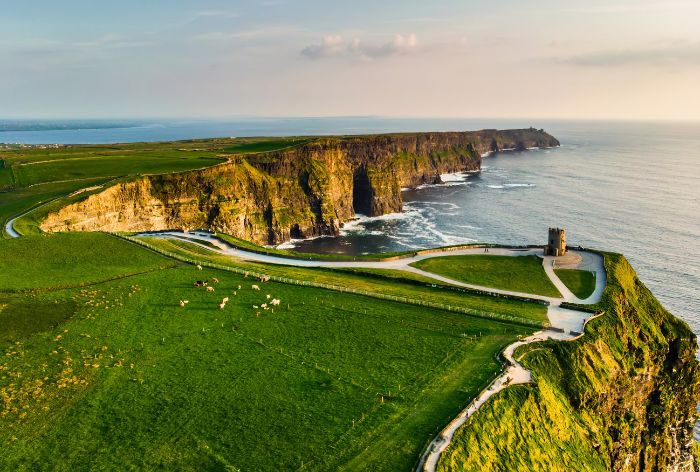
Cliffs of Moher: Ireland’s iconic coastal cliffs, towering over the Atlantic Ocean.
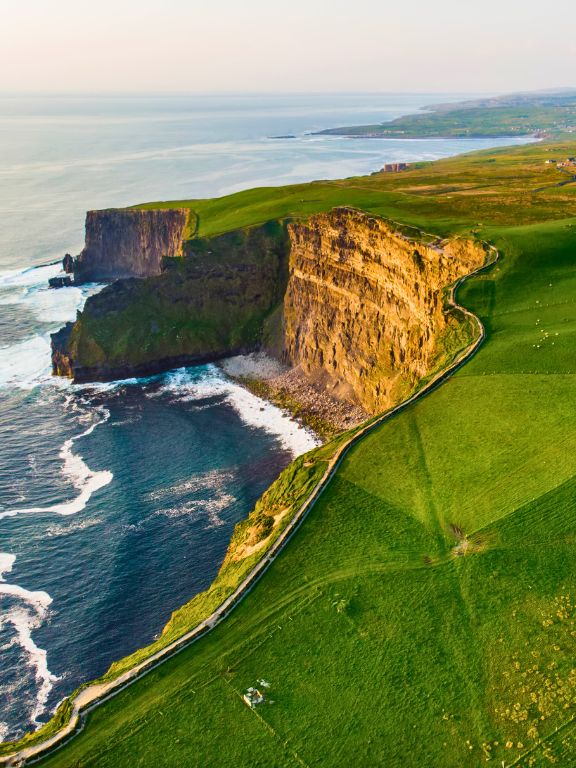
Spectacular Cliffs of Moher carved by the relentless forces of wind and waves.
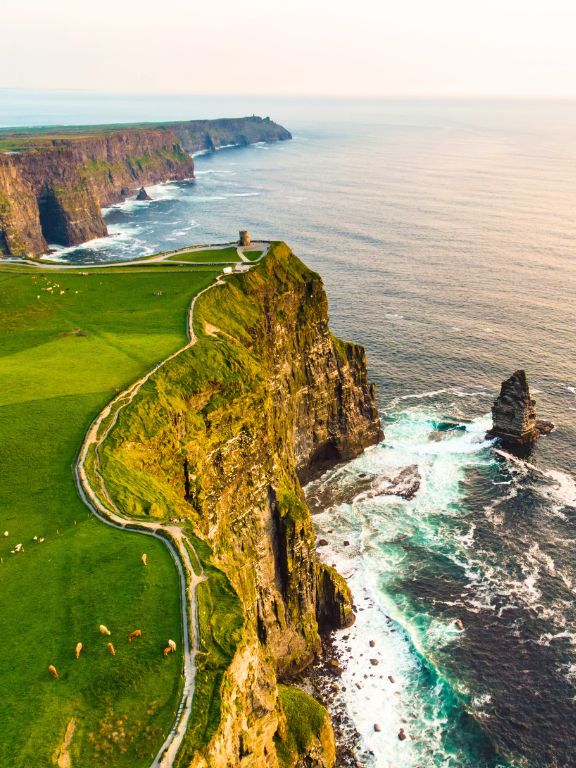
Cliffs of Moher: A must-see natural wonder, offering stunning views of Ireland’s west coast.
Guinness Storehouse
Located in the heart of Dublin, the Guinness Storehouse is a must-visit for beer enthusiasts and history buffs alike.
This seven-story museum tells the story of Ireland’s most famous export, Guinness beer, from its humble beginnings to its global success.
INTREPID’S TIP: You can do a self-guided tour through interactive exhibits, learn about the brewing process, and the brand’s advertising history, and even enjoy a complimentary pint of Guinness at the Gravity Bar, which boasts 360-degree views of Dublin’s skyline.
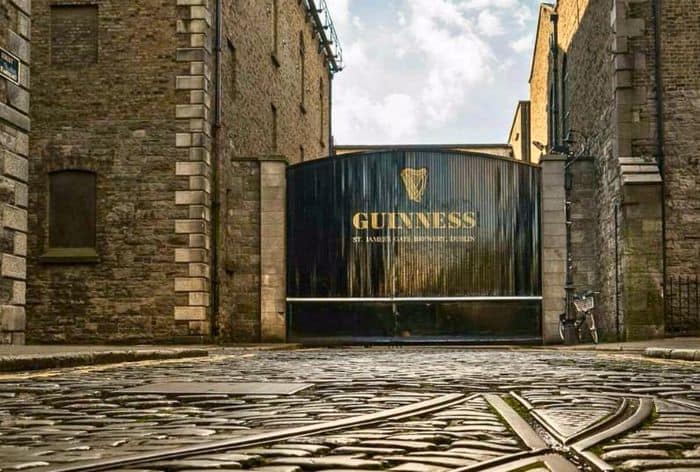
Guinness Storehouse: Home to the world’s largest pint glass, showcasing over 250 years of brewing excellence.
Ring of Kerry
The Ring of Kerry is a scenic drive that loops around the Iveragh Peninsula in County Kerry, offering some of Ireland’s most spectacular landscapes.
Along the 111-mile route, you can admire rolling hills, pristine lakes, picturesque villages, and rugged coastline.
Highlights include the Gap of Dunloe, a narrow mountain pass; Killarney National Park, home to the stunning Lakes of Killarney; and the charming town of Kenmare.
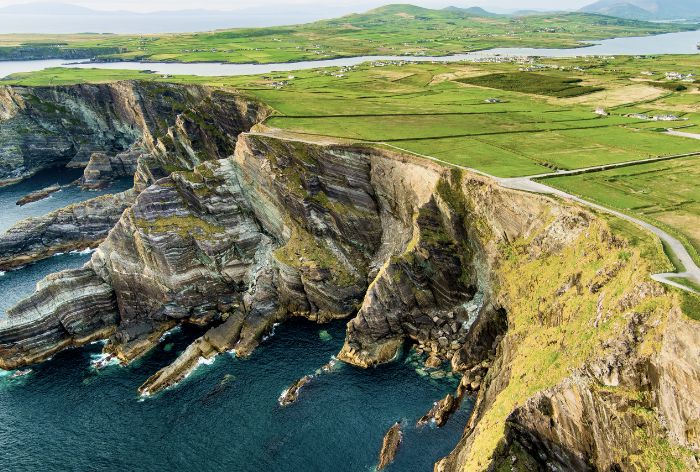
Kerry Cliffs are nature’s masterpiece towering over the Atlantic, and offering awe-inspiring views of Ireland’s rugged coastline.
Giant's Causeway
Situated on the rugged coast of County Antrim in Northern Ireland, the Giant’s Causeway is a UNESCO World Heritage Site renowned for its unique geological formations.
The causeway consists of approximately 40,000 interlocking basalt columns, formed millions of years ago by volcanic activity.
According to Irish mythology, the causeway was built by the giant Finn McCool as a pathway to Scotland.
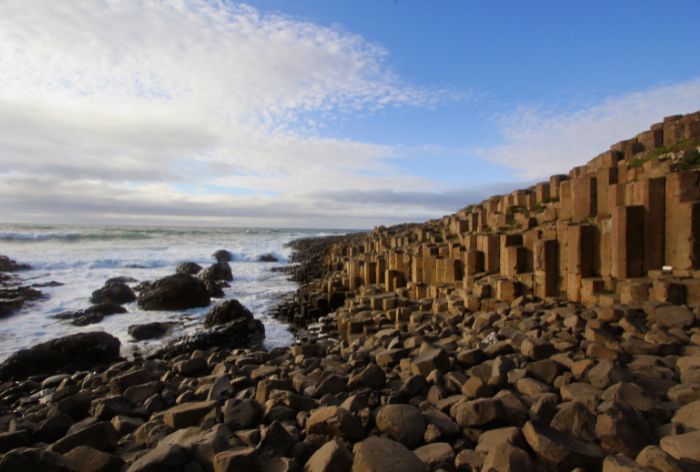
The mesmerizing basalt columns of Giant’s Causeway.
Blarney Castle and Gardens
Nestled in County Cork, Blarney Castle is famous for its legendary Blarney Stone, said to bestow the gift of eloquence upon those who kiss it.
Dating back to the 15th century, the castle is surrounded by lush gardens.
INTREPID’S TIP: Make sure to climb to the top of the castle’s battlements to kiss the Blarney Stone, explore the castle’s interior, and wander through the gardens, which offer walking trails.
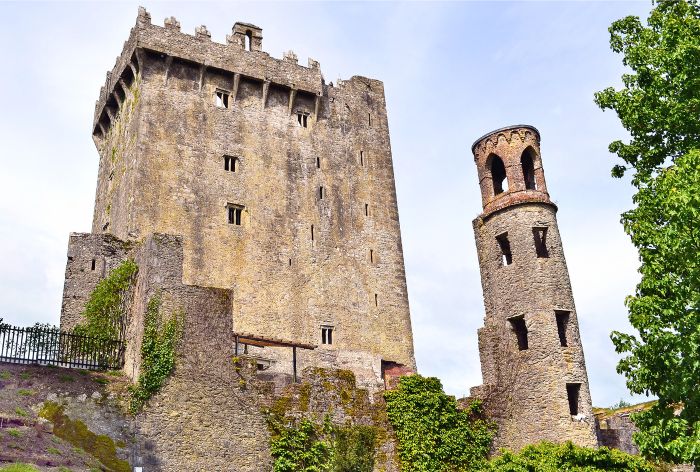
Blarney Castle, home to the iconic Blarney Stone, has stood for over 600 years, captivating visitors with its rich history.
Dublin Castle
Dublin Castle, located in the heart of Ireland’s capital city, is a historic landmark that reflects over 800 years of Irish history.
Originally built as a medieval fortress in the 13th century, the castle has undergone various renovations and additions over the centuries, blending different architectural styles including Gothic, Renaissance, and Georgian.
Today, it serves as a government complex and cultural center, hosting events, exhibitions, and guided tours for visitors. Highlights include the State Apartments, which showcase ornate decorations and ceremonial rooms, and the Dubhlinn Gardens.
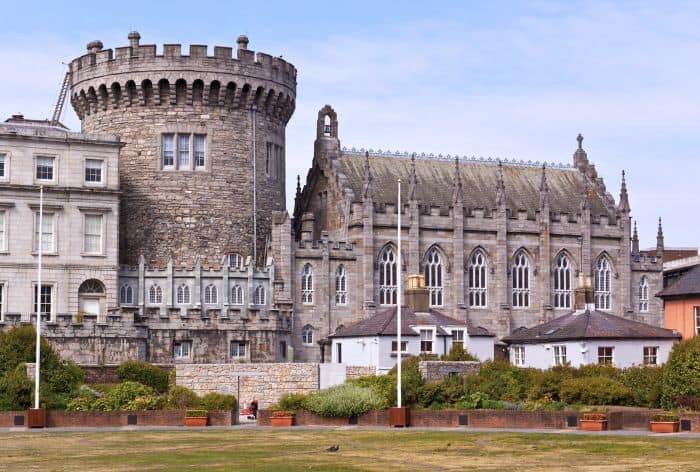
Dublin Castle symbolizes Dublin’s heritage and power, dating back to the 13th century, showcasing centuries of history and architectural grandeur.
Rock of Cashel
Perched atop a limestone hill in County Tipperary, the Rock of Cashel is a magnificent archaeological site.
Also known as St. Patrick’s Rock, this ancient fortress is home to a collection of medieval ecclesiastical buildings, including a round tower, cathedral, and Cormac’s Chapel, showcasing impressive Romanesque and Gothic architecture.
According to legend, the Rock of Cashel was the site where St. Patrick converted the King of Munster to Christianity by using a shamrock to explain the concept of the Holy Trinity.
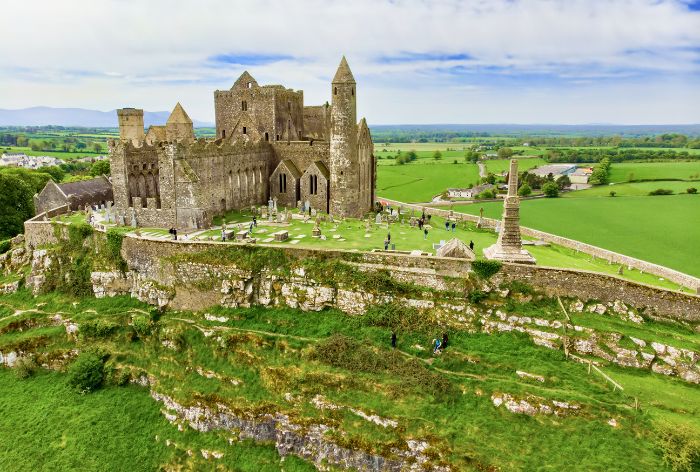
Rock of Cashel: A historic site in County Tipperary, Ireland, dating back to the 4th century, featuring medieval architecture and Celtic heritage.
Skellig Michael
Skellig Michael, located off the coast of County Kerry, is a rugged and remote island renowned for its ancient monastic settlement and dramatic natural beauty.
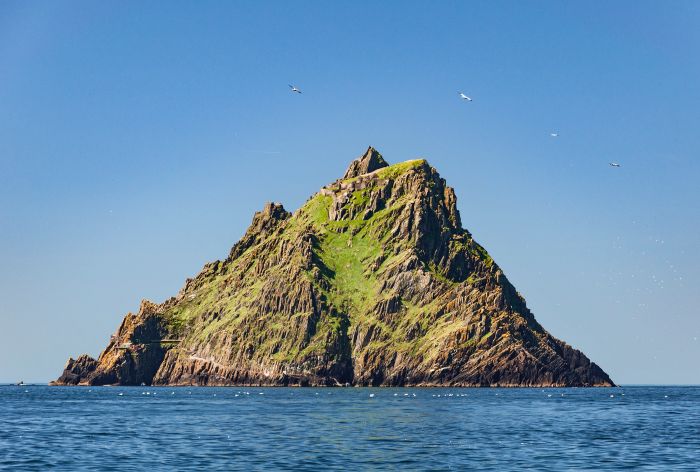
Skellig Michael is a UNESCO World Heritage Site off the coast of County Kerry, Ireland, renowned for its ancient monastic settlement dating back to the 6th century.
Designated as a UNESCO World Heritage Site, the island is home to a well-preserved sixth-century monastery perched atop steep cliffs, accessible via a challenging climb of over 600 stone steps.
You can explore the monastery’s beehive huts, oratories, and stone crosses, while also marveling at the island’s diverse birdlife, including puffins and gannets.
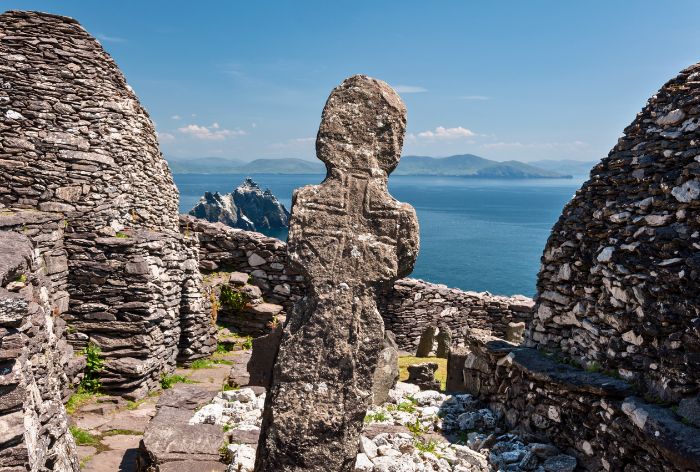
Skellig Michael’s rich history offers a glimpse into Ireland’s early Christian heritage.
Titanic Belfast
Located in the Titanic Quarter of Belfast, Titanic Belfast is an award-winning attraction telling the story of the ill-fated RMS Titanic, built in the city’s shipyards.
Housed within a striking architectural structure resembling the ship’s hull, the museum offers immersive exhibits, interactive displays, and audiovisual presentations that trace the Titanic’s construction, maiden voyage, and tragic sinking in 1912.
You can explore replicas of the ship’s interiors, including its luxurious cabins and grand staircase, as well as learn about the lives of the passengers and crew onboard.
Titanic Belfast also delves into Belfast’s maritime heritage and the city’s industrial legacy.
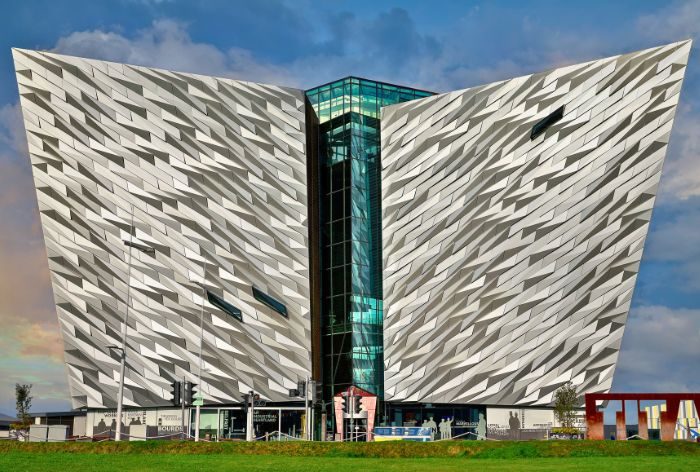
Titanic Belfast is a tribute to Belfast’s maritime legacy and the world-famous RMS Titanic.
The Burren
The Burren, located in County Clare, is a unique and otherworldly landscape characterized by its limestone pavements, karst formations, and rare flora.
Spanning over 250 square kilometers, this UNESCO Global Geopark offers a fascinating glimpse into Ireland’s geological past.
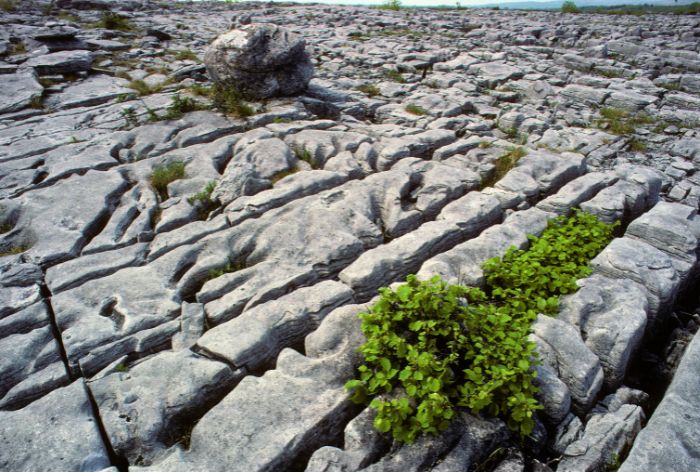
The Burren is a mesmerizing karst landscape in County Clare, Ireland, featuring ancient stone formations and diverse flora.
The Burren is also home to several archaeological sites. The most famous site in the Burren is Poulnabrone Dolmen, a Neolithic portal tomb dating back to around 4200 BC.
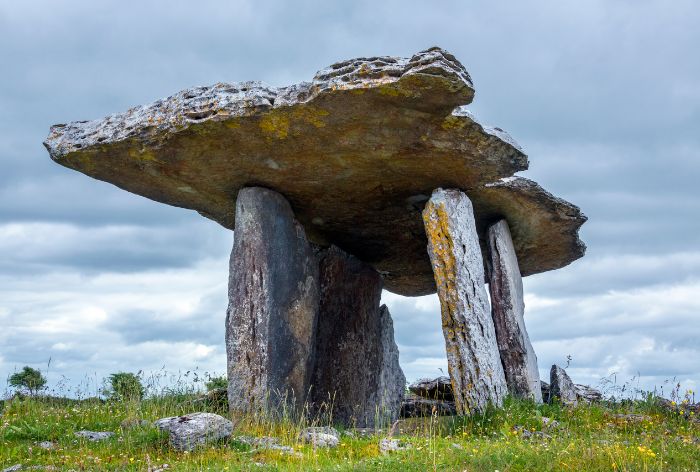
Explore the enigmatic beauty of the Burren, where Neolithic tombs and megalithic monuments stand amidst limestone pavements.
Killarney National Park
Killarney National Park, located in County Kerry, spans over 100 square kilometers. This protected area encompasses rugged mountains, pristine lakes, and lush woodlands, providing a haven for wildlife and outdoor enthusiasts.
You can explore the park’s scenic trails on foot, bike, or horseback, encountering iconic landmarks such as the Gap of Dunloe, Torc Waterfall, and Muckross House and Gardens and Muckross Abbey.
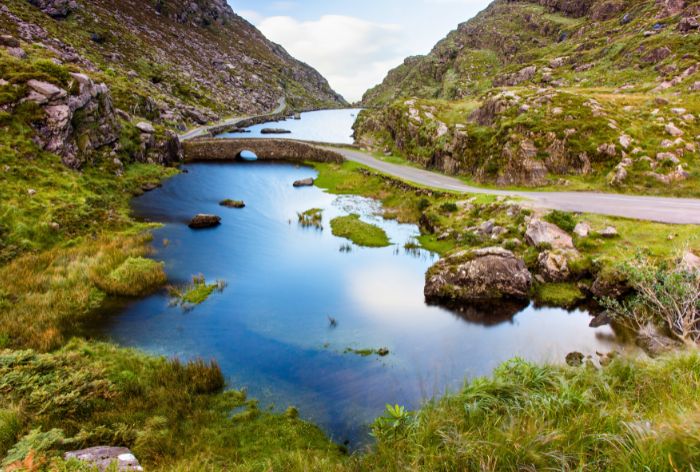
Gap of Dunloe is a scenic mountain pass in County Kerry that offers breathtaking views of rugged terrain and pristine lakes.
Newgrange
Newgrange is a prehistoric passage tomb located in the Boyne Valley of County Meath, dating back over 5,000 years to the Neolithic period.
Recognized as one of Ireland’s most important archaeological sites, Newgrange is renowned for its remarkable megalithic architecture, intricate stone carvings, and astronomical significance.
During the winter solstice, sunlight penetrates the tomb’s narrow entrance and illuminates the central chamber, marking the beginning of a new year according to ancient rituals.
You can explore the site on guided tours, and learn about its construction, purpose, and cultural significance.
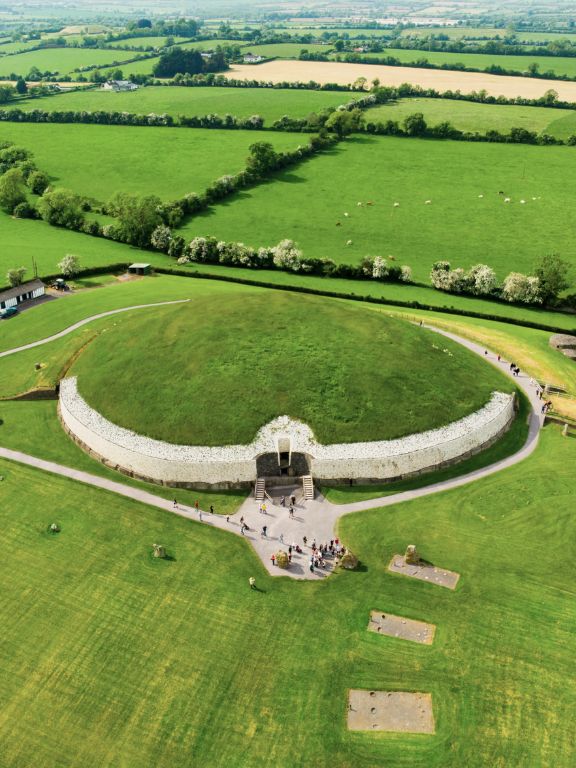
Newgrange is a prehistoric passage tomb in County Meath, older than Stonehenge and the Great Pyramids, built around 3200 BC.
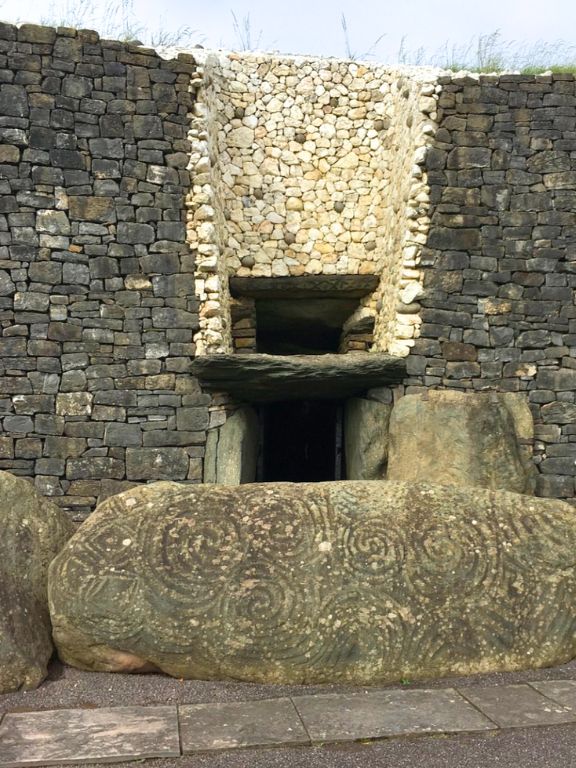
Step back in time at Newgrange, where sunlight illuminates the chamber during the winter solstice, a testament to ancient astronomical knowledge
Trinity College and the Long Room
Trinity College in Dublin is Ireland’s oldest university, founded in 1592, and is renowned for its historic architecture, scholarly traditions, and cultural treasures.
Among its notable features is the Old Library, home to the iconic Book of Kells, a lavishly illustrated manuscript dating back to the 9th century and containing the four Gospels of the New Testament. The Book of Kells exhibition offers a rare opportunity to view this masterpiece of medieval artistry up close, as well as learn about its creation, history, and enduring legacy.
Additionally, the Old Library houses the Long Room, a majestic chamber lined with thousands of ancient books, manuscripts, and artifacts.
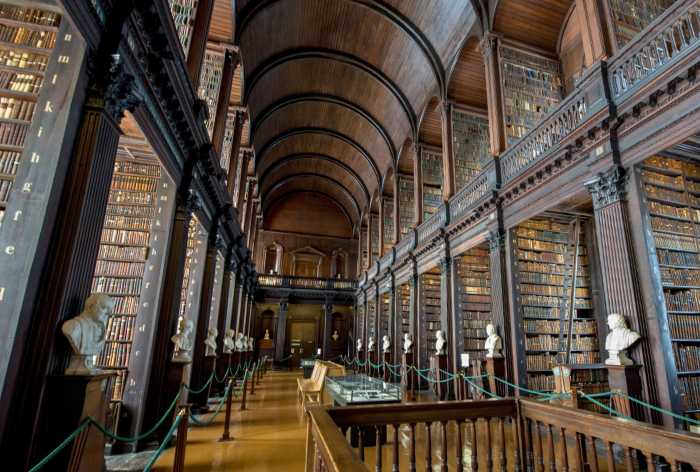
Long Room is the majestic chamber of Trinity College’s Old Library boasting towering shelves adorned with centuries-old manuscripts and books.
Temple Bar District
Temple Bar District is a vibrant cultural and entertainment quarter located in the heart of Dublin’s city center.
Known for its lively atmosphere, colorful facades, and eclectic mix of bars, restaurants, and galleries, Temple Bar is a must-visit destination.
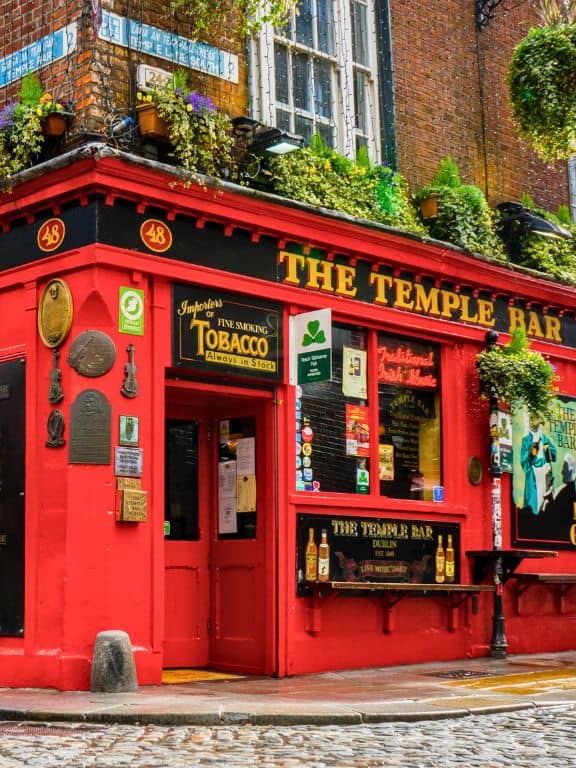
Temple Bar: Dublin’s lively cultural hotspot, filled with music, art, and pubs, perfect for exploring the city’s vibrant scene.
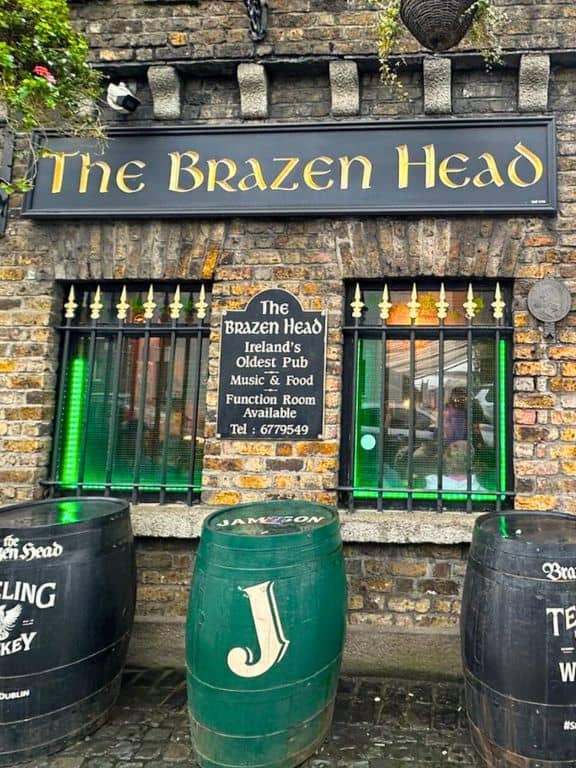
Brazen Head: Dublin’s Oldest Pub, steeped in centuries of history and charm, where tales and pints have flowed since 1198.
Kilmainham Gaol
Kilmainham Gaol is a former prison located in Dublin, originally built in 1796. It holds significant historical importance, particularly in the context of Ireland’s struggle for independence. Many key figures in Irish history were imprisoned here, and it was the site of numerous executions.
Today, Kilmainham Gaol is open to the public as a museum and offers guided tours that provide insight into its history and the conditions endured by prisoners. The prison’s Victorian architecture is well-preserved and offers a glimpse into the past.
It’s a must-visit for those interested in Irish history and the fight for independence!
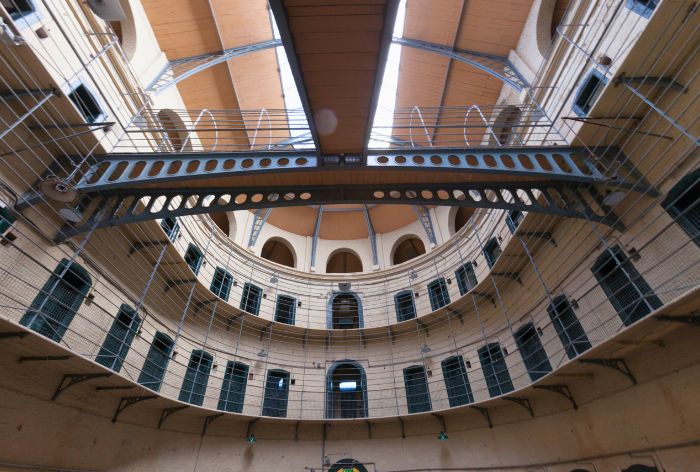
Kilmainham Gaol: A symbol of Ireland’s struggle for independence, where history echoes through its stark corridors and haunting cells.
The Jameson Distillery
The Jameson Distillery, located in Dublin, is an iconic Irish whiskey distillery with a rich history dating back to 1780. It was founded by John Jameson and has since become one of the world’s most renowned whiskey brands.
The distillery offers guided tours that will take you through the whiskey-making process, from the mashing and fermentation of barley to the triple distillation in copper pot stills. The tour concludes with a whiskey-tasting session, where you can sample various Jameson expressions and learn about the distinct flavors and aromas of each.
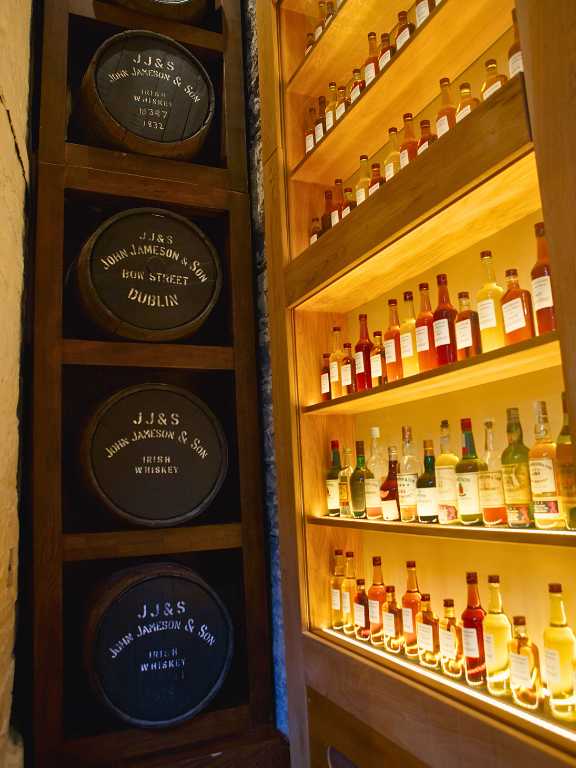
Jameson Distillery: Where the spirit of Ireland comes to life, crafting world-renowned whiskey since 1780.
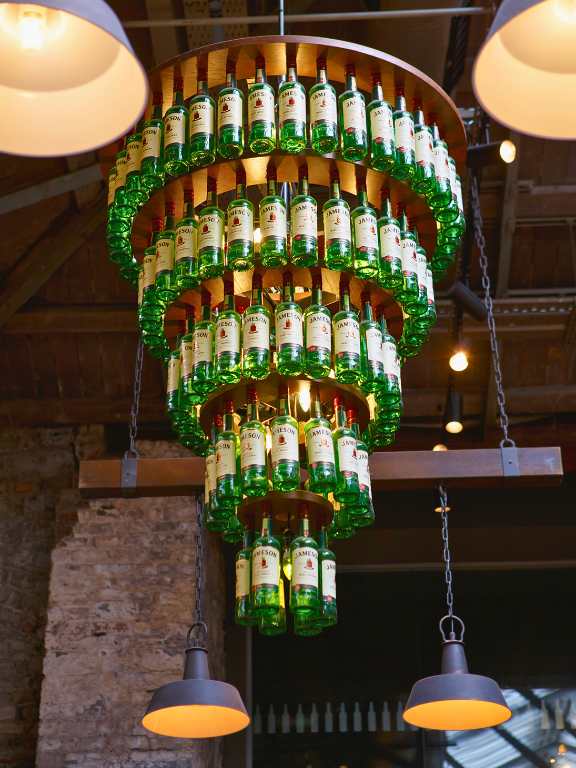
Discover the art and heritage behind Ireland’s most famous whiskey at the Jameson Distillery, where tradition meets innovation.
The Dark Hedges
The Dark Hedges is a stunning avenue of beech trees located in County Antrim, Northern Ireland.
Planted in the 18th century as a grand entrance to a nearby mansion, the trees have since grown to form a picturesque tunnel-like canopy, creating an atmospheric setting.
The Dark Hedges gained international fame after being featured in the popular television series “Game of Thrones” as the Kingsroad.
Today, it is one of Northern Ireland’s most photographed natural attractions.
INTREPID’S TIP: Make sure to schedule your visit to the Dark Hedges during sunrise or sunset. The avenue is particularly enchanting during those hours when the sunlight filters through the branches.
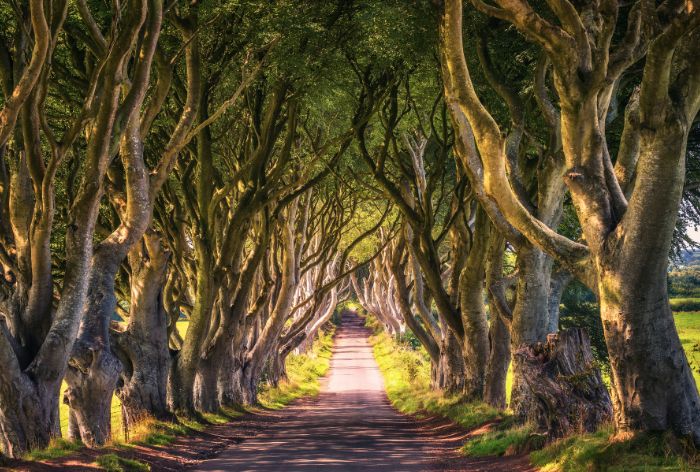
The Dark Hedges is a hauntingly beautiful avenue of beech trees in Northern Ireland, famous for its atmospheric allure and iconic appearance.
Dingle Peninsula
The Dingle Peninsula is a rugged and scenic stretch of coastline located in County Kerry, on the southwest coast of Ireland.
Driving the Slea Head Drive, a scenic route around the peninsula’s perimeter is a popular way to explore its highlights, including rugged cliffs, sandy beaches, and ancient archaeological sites.
Dingle Town, the main hub of the peninsula, is a colorful fishing village known for traditional pubs.
You can also discover the area’s Gaelic heritage by visiting historical sites such as the Gallarus Oratory, an ancient stone church dating back to the 6th century, and the Blasket Islands Centre, which celebrates the unique culture of the now-deserted Blasket Islands.
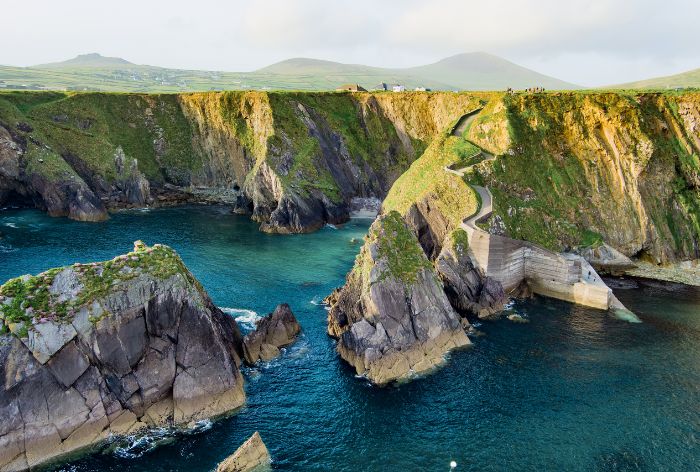
Dunquin Pier on the Dingle Peninsula served as a vital link to the Blasket Islands until 1953. This historic pier offers stunning views of the Atlantic.
Carrick-a-Rede Rope Bridge
Carrick-a-Rede Rope Bridge is a thrilling and iconic attraction located along the Causeway Coastal Route in County Antrim, Northern Ireland.
Spanning a 20-meter chasm and suspended over 30 meters above the Atlantic Ocean, the bridge offers breathtaking views of the rugged coastline and the surrounding cliffs.
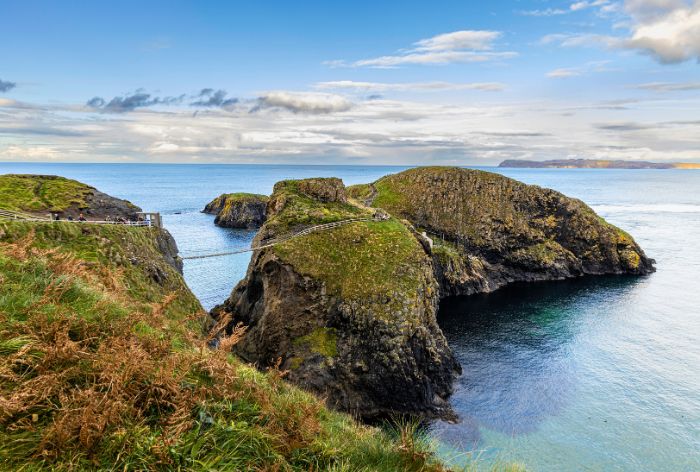
Carrick-a-Rede Island boasts rugged cliffs and abundant wildlife, making it a photographer’s paradise.
Originally erected by salmon fishermen over 350 years ago, the National Trust now maintains the bridge
Crossing the bridge is a thrilling experience. Once on the other side, you can explore the island of Carrick-a-Rede, with its walking trails.
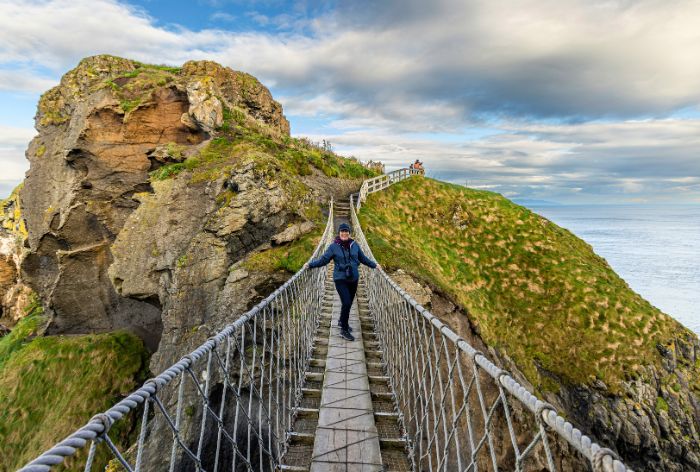
Crossing Carrick-a-Rede Rope Bridge offers unparalleled views of Northern Ireland’s stunning coastline.
Dunluce Castle
Dunluce Castle is a medieval ruin perched dramatically on a cliff edge overlooking the Atlantic Ocean in County Antrim, Northern Ireland.
Dating back to the 13th century, the castle has a storied history, including occupation by various noble families and a tumultuous past marked by sieges and battles.
You can explore its atmospheric ruins, including the remains of the Great Hall, kitchens, and residential quarters, all set against the backdrop of stunning coastal views.
Dunluce Castle is a must-visit destination along the Causeway Coastal Route.
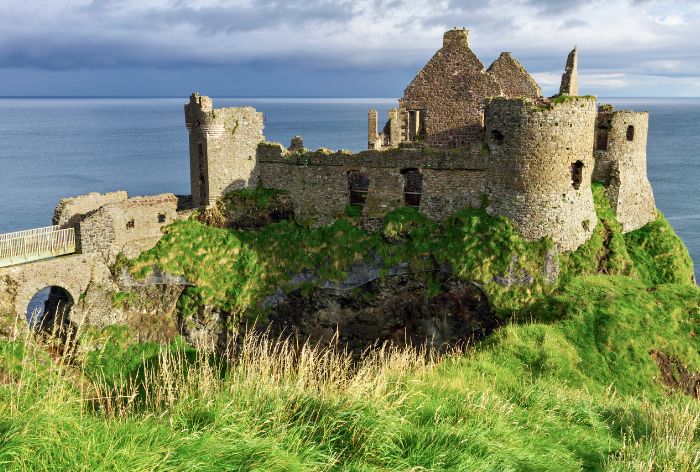
Dunluce Castle: A medieval stronghold on County Antrim’s cliffs, offering a glimpse into Ireland’s turbulent past.
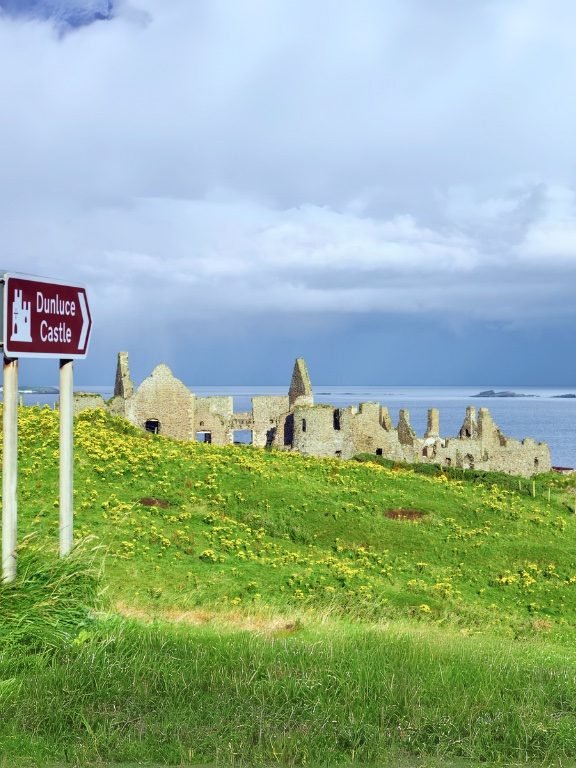
Explore the atmospheric ruins of Dunluce Castle, steeped in centuries of legend and lore.
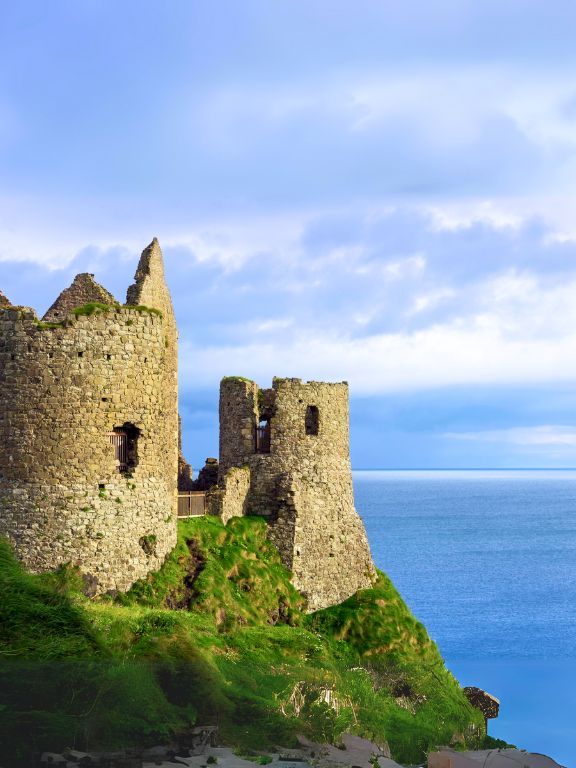
Dunluce Castle’s precarious perch offers sweeping views of the Atlantic Ocean, a testament to its enduring allure.
More Information About Ireland:
9 Amazing Things to Do in Killarney National Park (Maps+Tips)
22 Best Stops on the Ring of Kerry (Map+Top Attractions at Each Stop)
Perfect 1-Day Ring of Kerry Drive Itinerary
16 Best Stops on the Dingle Peninsula Drive (map+detailed tips)
You Might Also Like:
82 Quotes About Ireland And the Irish Spirit Celebrating the Emerald Isle
102 Beautiful Irish Proverbs and Sayings Offering Timeless Lessons
92 Irish Blessings And Wishes Embracing Joy on St. Patrick’s Day
Did You Find Must-See Sights and Attractions in Ireland Useful? Pin It!
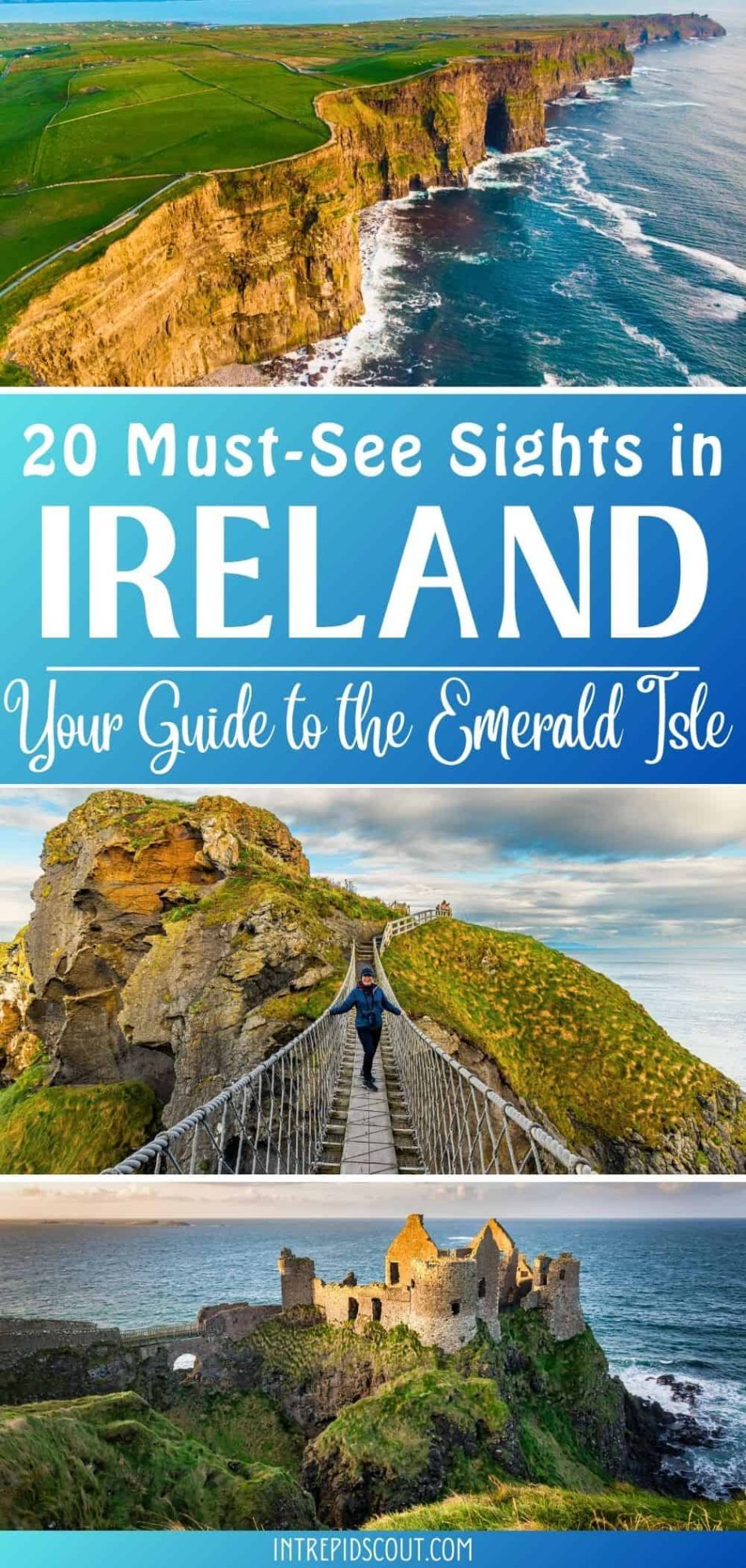
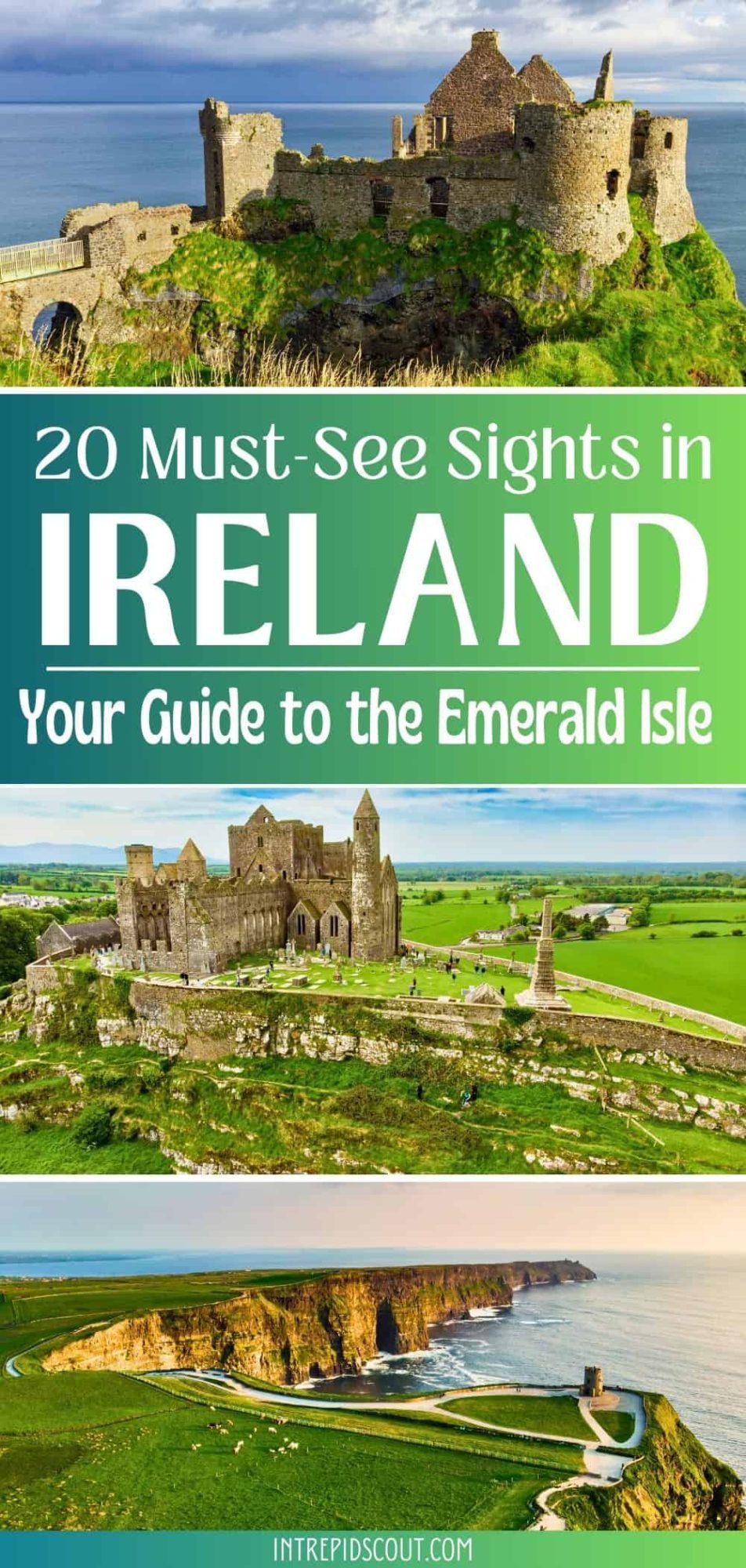
Now, It Is Your Turn, I Would Like to Hear Back from You!
Are you planning your trip to Ireland?
Please let me know! Drop me a quick comment right below!
Click on any of the images below to get inspired and to help you with the planning process for your trip to Ireland!

